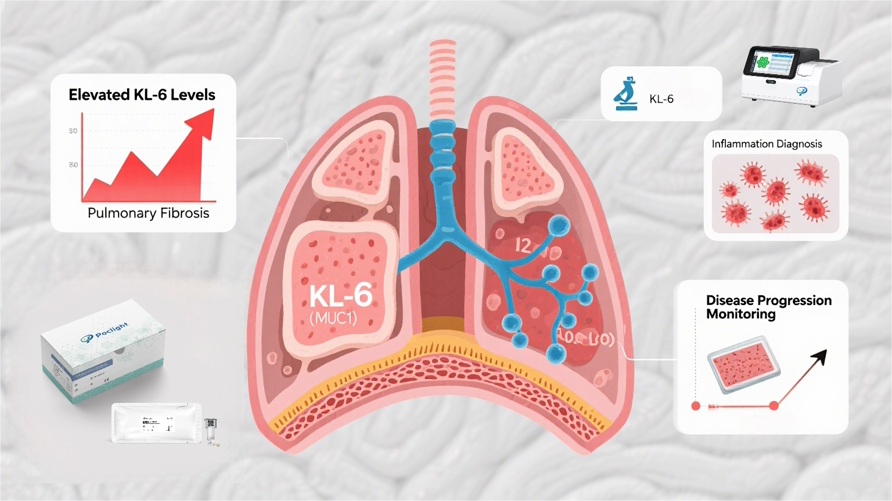1.KL-6 Testing Solutions
KL-6 (Krebs von den Lungen-6)assay kit is a high-molecular-weight mucin belonging to the MUC1 glycoprotein family, primarily secreted by type II alveolar epithelial cells. Clinical studies have shown that elevated KL-6 levels correlate closely with pulmonary fibrosis, inflammation diagnosis, and disease progression.

2. Diseases Associated with KL-6
KL-6 is a key serum biomarker for respiratory diseases, particularly ILD. Elevated levels are commonly seen in:
- Idiopathic Pulmonary Fibrosis (IPF)
- Nonspecific Interstitial Pneumonia (NSIP)
- Autoimmune disease–associated ILD – e.g., systemic sclerosis, Sjögren’s syndrome, dermatomyositis
- Drug-induced or radiation-induced lung injury
- Severe infections / viral pneumonia (e.g., COVID-19)
- Acute Respiratory Distress Syndrome (ARDS)
These conditions are all associated with alveolar epithelial injury. KL-6 testing offers a non-invasive, repeatable, and quantitative monitoring tool.
3. Key Points for Therapeutic Monitoring
In clinical management, KL-6 is valuable for:
- Baseline assessment – initial measurement at diagnosis for comparison in follow-up
- Therapeutic tracking – re-testing 1–3 months after treatment to evaluate improvement or deterioration
- Relapse prediction – re-elevated KL-6 may indicate recurrence or complications
- Multi-marker combination – combining KL-6 with SP-D, LDH, and imaging to improve accuracy
4. Global KL-6 Testing Market Size & Major Brand Comparison
(1) Global Market Size (Preliminary Estimate)
① Japan – Largest Market: KL-6 is widely used in Japan for diagnosing and monitoring interstitial lung disease (ILD) and is covered by national health insurance. Annual testing volumes are likely in the hundreds of thousands to over one million.
② Europe & North America: KL-6 is used mainly for research or as an auxiliary diagnostic biomarker. It has not yet been widely adopted as part of routine clinical practice, but the market is in a growth phase.
③ Impact of COVID-19: The pandemic increased global awareness of KL-6, especially in respiratory disease monitoring. Future application scenarios may further expand.
(2) Major Brands & Product Comparison
| Brand / Platform |
Detection Method |
Product Features |
QC & Price* |
| Fujirebio |
CLEIA |
High sensitivity,high-throughput |
Auto QC; $$$ (High) |
| Eisai / EIDIA |
ECLIA |
Clinical-grade stability |
Hospital labs; $$$ |
| BioVendor |
ELISA / Latex |
Simple, low-cost |
~$630 / 96 wells |
| MyBioSource / Creative Diagnostics |
ELISA |
Multi-brand, research use |
€500–600 / 96 tests |
| Poclight |
Homogeneous CLIA |
No cold chain, portable, 3-15 min TAT,18-month RT; |
Free QC with MOQ reagent purchase |
*Price: $ = low, $$ = medium, $$$ = high
5. Accurate KL-6 Measurement with Chemiluminescence Immunoassay (CLIA)
Compared with ELISA, CLIA offers clear benefits in KL-6 detection.CLIA is a technique that combines immunoreactions with chemiluminescent signal detection, well-suited for highly sensitive quantitative measurement of low-concentration biomarkers like KL-6.
Testing workflow:
- Antigen–antibody binding – KL-6 binds to an immobilized primary antibody
- Signal amplification – a labeled secondary antibody forms a sandwich complex
- Chemiluminescent reaction – the label catalyzes substrate to emit light
- Signal detection & calculation – light intensity is proportional to KL-6 concentration
6. Typical Case
Case: A patient with systemic sclerosis presented with a KL-6 level of 1800 U/mL at diagnosis (significantly elevated). After 3 months of immunosuppressive therapy, the level decreased to 950 U/mL, imaging showed reduced fibrotic lesions, and dyspnea symptoms improved.
Insight: KL-6 is not only useful for disease detection, but also for quantifying therapeutic response, providing physicians with evidence to adjust treatment plans.
7. Rapid Testing Advantages of the Poclight C5000
The Poclight C5000 POCT CLIA analyzer offers several competitive advantages for KL-6 testing:
- No cold-chain reagent requirement – easier transport and storage, reduced wastage
- Portable and compact – suitable for primary hospitals, clinics, and mobile healthcare units
- Simple operation – six steps to complete testing, results within 5 minutes

- Multi-assay platform – runs KL-6 alongside other inflammatory markers on the same device
- High-precision results – CLIA sensitivity comparable to large fully automated platforms
- On-demand testing – ideal for emergency and bedside use in inpatient wards

 English
English français
français русский
русский español
español português
português العربية
العربية 日本語
日本語 Türkçe
Türkçe हिंदी
हिंदी Indonesia
Indonesia 








 IPv6 network supported |
IPv6 network supported | 